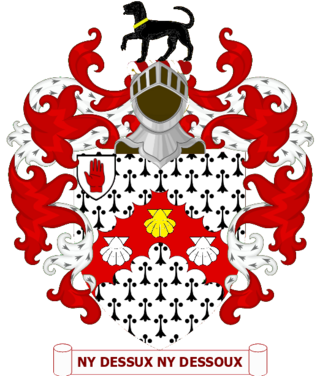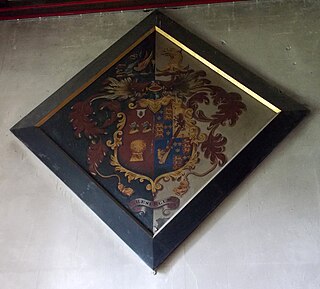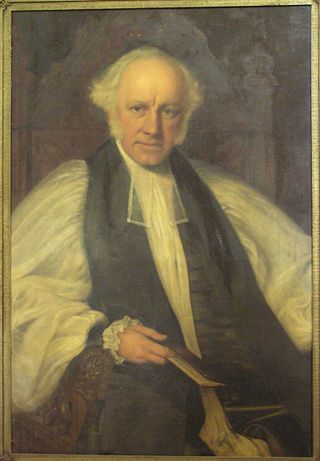
The Scott baronetcy, of Abbotsford in the County of Roxburgh, was created in the Baronetage of the United Kingdom on 22 April 1820 for the author Sir Walter Scott. [1] The title became extinct on the death of the second Baronet in 1847.

The Scott baronetcy, of Abbotsford in the County of Roxburgh, was created in the Baronetage of the United Kingdom on 22 April 1820 for the author Sir Walter Scott. [1] The title became extinct on the death of the second Baronet in 1847.

Lord Napier, of Merchistoun, is a title in the Peerage of Scotland. It was created in 1627 for Sir Archibald Napier, 1st Baronet. Earlier that year, he already held the Napier Baronetcy, of Merchistoun in the County of Midlothian, created in the Baronetage of Nova Scotia. The titles remained united until 1683, when the Baronetcy became dormant. It was revived in the early 19th century and is now held by another branch of the Napier family. Between 1683 and 1686, the Lords of Napier also held the Nicolson Baronetcy, of Carnock in the County of Stirling, and since 1725 the Scott Baronetcy, of Thirlestane in the County of Selkirk, both baronetcies created in the Baronetage of Nova Scotia. The latter one is held till today. Additionally, the tenth Lord was created Baron Ettrick, of Ettrick in the County of Selkirk in the Peerage of the United Kingdom on 16 July 1872.
There have been two baronetcies created for a person with the surname Clifford.

There have been twelve baronetcies created for people with the surname Scott, one in the Baronetage of England, two in the Baronetage of Nova Scotia, and nine in the Baronetage of the United Kingdom.
There have been four baronetcies for persons with the surname Blake, one in the Baronetage of Ireland, two in the Baronetage of Great Britain and one in the Baronetage of the United Kingdom. Two of the creations are extant as of 2010. The Blake Baronetcy, of Menlough in the County of Galway, was created in the Baronetage of Ireland on 10 July 1622 for Valentine Blake, Mayor of Galway in 1611 and 1630 and a member of the Irish House of Commons for County Galway. His grandfather Thomas Blake had preceded him as Mayor. The second Baronet was a member of the Irish Parliament for Galway Borough. The third Baronet represented both County Galway and Galway Borough in Parliament. The sixth Baronet was a member of the Irish House of Commons for County Galway. He was the first Catholic gentlemen of distinction to join William of Orange. The twelfth Baronet represented Galway Borough in the British House of Commons. The fourteenth Baronet was high sheriff of County Galway in 1872. See also the Blake Baronetcy of Twizell Castle below.

There have been three baronetcies created for persons with the surname Chichester, one in the Baronetage of England and two in the Baronetage of the United Kingdom. Only the 1641 creation is extant.

Sir Thomas Frazer Grove, 1st Baronet was an English Liberal politician who sat in the House of Commons between 1868 and 1892.
There have been two baronetcies created for persons with the surname Carden, one in the Baronetage of Ireland and one in the Baronetage of the United Kingdom. Both creations are extant as of 2010.

The Blunt Baronetcy, of the City of London, is a title in the Baronetage of Great Britain. It was created on 17 June 1720 for John Blunt, the famous perpetrator of the South Sea Bubble, for his good work for the nation of Great Britain. From 1703 he was the secretary of the Hollow Sword Blade Company, a joint-stock company effectively operating as a bank. He was a director of the South Sea Company from 1711. He was the main architect of the ambitious scheme for the company to assume the National Debt, and when the bribery and fraud were revealed, Parliament confiscated all his assets except £5,000, while most directors were allowed to retain £10,000.
There have been two baronetcies created for persons with the surname Williamson, one in the Baronetage of England and one in the Baronetage of the United Kingdom.

The Feilden Baronetcy, of Feniscowles in the County Palatine of Lancaster, is a title in the Baronetage of the United Kingdom. It was created on 21 July 1846 for William Feilden, Member of Parliament for Blackburn between 1832 and 1847. He sat as a Liberal from 1832 to 1841 then as a Conservative from then until 1847.

The Currie Baronetcy is a title in the Baronetage of the United Kingdom. It was created on 11 January 1847 for Frederick Currie, Foreign Secretary to the Indian Government and a member of the Supreme Council of India. He was a grandson of William Currie (1721–1781), nephew of William Currie (1756–1829), who was Member of Parliament for Upper Gatton and Winchelsea, and the brother of Vice-Admiral Mark John Currie.

There have been two baronetcies created for members of the Burgoyne family, one in the Baronetage of England and one in the Baronetage of the United Kingdom. Both creations are extinct.

Sir Francis Edward Scott, 3rd Baronet was an English landowner.
There have been two baronetcies created for members of the Haggerston, later Constable Maxwell-Scott family, one in the Baronetage of England and one in the Baronetage of the United Kingdom. Only one creation is extant as of 2008. The Haggerston, later Constable Maxwell-Scott Baronetcy, of Haggerston in the County of Northumberland, was created in the Baronetage of England on 15 August 1642 for Thomas Haggerston, of Haggerton Castle, Northumberland, a loyal Royalist who served as a colonel in the army of King Charles I. The Haggerston were recusant in the 17th century and the estates were sequestered and forfeit to the Commonwealth of England in 1649 but were repurchased by the first Baronet in 1653. The line of the fourth Baronet failed on the death of the twelfth Baronet in 1972. The title reverted to the line of William Haggerston, second son of the third Baronet and younger brother of the fourth Baronet. In 1746 he inherited estates in Yorkshire from his great-uncle Sir Marmaduke Francis Constable, 4th and last Baronet, of Everingham, and assumed the surname of Constable in lieu of his patronymic. In 1758 he married Winifred, daughter of Robert Maxwell, titular sixth Earl of Nithsdale, and assumed by Royal licence the additional surname of Maxwell. Winifred was considered to be the heiress to the Scottish lordship of Herries of Terregles held by her father. Constable-Maxwell built a new house at Everingham Park on the Constable estate in Yorkshire.

The Craufurd Baronetcy, of Kilbirney in south-west Scotland, is a title in the Baronetage of Great Britain. It was created on 8 June 1781 for Alexander Craufurd, the member of an ancient Scottish family. The General and Major-General were elected to the Nottinghamshire East Retford of the almost wholly unreformed (pre-1832) House of Commons.
There have been two baronetcies created for members of the Macdonald family, one in the Baronetage of Nova Scotia and one in the Baronetage of the United Kingdom. One creation is extant.

Sir Montague John Cholmeley, 2nd Baronet was a British Liberal Party politician and baronet.

Joseph Cotton Wigram was a British churchman, Archdeacon of Winchester and bishop of Rochester.

The Smith, later Eardley Baronetcy, of Hadley in the County of Middlesex, was a title in the Baronetage of the United Kingdom. It was created on 22 December 1802 for Culling Smith. He was the son of Thomas Smith, a London merchant. The second Baronet married the Honourable Charlotte Elizabeth, daughter of Sampson Eardley, 1st Baron Eardley. Their son, the third Baronet, assumed by Royal licence the surname of Eardley in lieu of his patronymic in 1847. He was a Christian campaigner for religious freedom and for Protestant causes. The title became extinct at the death of his son, the fourth Baronet, in 1875.
There have been two baronetcies created for persons with the surname East, one in the Baronetage of Great Britain and one in the Baronetage of the United Kingdom.